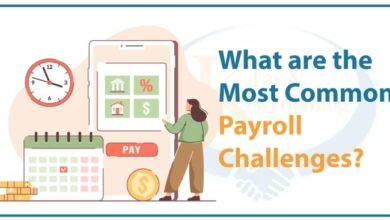
Balancing work and study tips for payroll diploma seekers are crucial for success. This guide delves into effective time management, utilizing valuable resources, and mastering study habits. We’ll explore strategies for maintaining a healthy work-life balance, leveraging technology, and overcoming challenges along the way.
From creating detailed weekly schedules to understanding the benefits of study groups, this comprehensive resource equips you with practical advice to navigate the demanding path of a working student pursuing a payroll diploma. Learn how to effectively manage your time, optimize your learning process, and build a supportive environment for long-term success.
Time Management Strategies for Balancing Work and Study
Juggling work and studies is a common challenge, especially for those pursuing a payroll diploma. Effective time management is crucial for success in this demanding endeavor. This involves not just scheduling but also prioritizing tasks and developing strategies to avoid feeling overwhelmed. This guide offers practical techniques to help you navigate this dual commitment.Effective time management is paramount for payroll diploma seekers.
It’s about creating a structured approach to allocate your time efficiently between your work responsibilities and your studies. This approach enables you to accomplish both effectively and maintain a healthy work-life balance.
Time Management Techniques for Students
Time management techniques are essential tools for students balancing work and studies. They provide structure and focus, minimizing stress and maximizing productivity. Understanding and applying these techniques can lead to significant improvements in academic performance and career advancement.
- The Pomodoro Technique: This technique involves working in focused intervals (typically 25 minutes) followed by short breaks. This structured approach helps maintain concentration and prevents burnout. Regular breaks help maintain focus during study sessions and prevent mental fatigue.
- The Eisenhower Matrix: This method categorizes tasks based on urgency and importance. This allows you to prioritize tasks effectively, focusing on high-priority items first. It helps identify and tackle crucial tasks while delegating or postponing less important ones.
- Time Blocking: This technique involves allocating specific time blocks for different tasks, including study, work, and personal activities. This provides a clear visual representation of your schedule, making it easier to track your progress and manage your time effectively.
Prioritizing Tasks Between Work and Study
Prioritizing tasks is vital for effectively managing both work and study commitments. A structured approach allows you to focus on the most important tasks first, leading to improved efficiency and productivity.
- Identify Urgent and Important Tasks: Use the Eisenhower Matrix to differentiate between urgent and important tasks. Urgent tasks require immediate attention, while important tasks contribute to long-term goals. Focus on the important tasks first.
- Break Down Large Tasks: Large tasks, like studying for an exam or completing a project, can feel overwhelming. Breaking them down into smaller, more manageable steps makes them less daunting and allows you to track your progress more effectively.
- Set Realistic Expectations: Acknowledge the demands of both work and study. Setting realistic expectations for your workload is crucial for avoiding burnout and maintaining a healthy work-life balance.
Creating a Weekly Schedule
A well-structured weekly schedule is essential for balancing work and study. It provides a roadmap for your week, ensuring you dedicate sufficient time to both commitments.
- Allocate Specific Time Slots: Allocate specific time slots for work, study, and personal activities in your weekly schedule. This creates a clear structure and helps you manage your time effectively.
- Consider Weekday and Weekend Activities: Consider the different demands of weekdays and weekends. Weekdays often involve work and study, while weekends might offer more flexibility for personal time or leisure activities.
- Review and Adjust: Review your weekly schedule regularly and make adjustments as needed to ensure it remains aligned with your priorities and responsibilities.
Sample Daily Schedule Template
This template provides a framework for managing your daily schedule. Adjust the times and activities to match your specific work and study commitments.
- 7:00 AM – 8:00 AM: Wake up, breakfast, and prepare for the day. Morning study session for 1 hour.
- 8:00 AM – 5:00 PM: Work Schedule.
- 5:00 PM – 6:00 PM: Commute and Dinner.
- 6:00 PM – 8:00 PM: Study time.
- 8:00 PM – 9:00 PM: Dinner, Relaxation, or personal activities.
- 9:00 PM onwards: Wind down, sleep.
Comparison of Time Management Methods
This table compares different time management methods suitable for part-time students.
| Method | Description | Strengths | Weaknesses |
|---|---|---|---|
| Pomodoro Technique | Focused work intervals with short breaks | Improved concentration, reduced burnout | May not suit all task types |
| Eisenhower Matrix | Prioritizing tasks by urgency and importance | Efficient task management, reduced stress | Requires consistent self-assessment |
| Time Blocking | Allocating specific time slots for tasks | Clear schedule, enhanced productivity | May be rigid for unpredictable tasks |
Utilizing Resources and Support Systems: Balancing Work And Study Tips For Payroll Diploma Seekers
Balancing work and study requires more than just time management; it demands strategic utilization of available resources. Knowing where to turn for assistance, whether it’s online learning platforms or campus support, can significantly ease the workload and enhance the learning experience. This section explores various avenues for support, empowering payroll diploma seekers to navigate the challenges and maximize their academic success.
Online Resources and Educational Platforms
Effective use of online resources can dramatically improve the learning experience for working students. Numerous platforms offer tailored learning materials, practice exercises, and interactive tools specifically designed for diverse learning styles. These resources often provide supplementary information beyond the core curriculum, offering a deeper understanding of the subject matter. Many online platforms also offer interactive forums where students can connect with peers and instructors to clarify doubts and exchange insights.
Juggling work and study for a payroll diploma can be tough, but there are some great tips to make it easier. Prioritize tasks, create a realistic schedule, and find a study buddy for support. Also, keeping up with social media, like checking out the latest privacy updates on Facebook ( facebook gives a little gets a little with new privacy settings ), can sometimes help you unwind after a long day.
Remember, staying organized and focused on your goals is key to successfully balancing both work and your diploma pursuit.
- Online learning platforms like Coursera, edX, and Khan Academy provide a wealth of free and paid educational content, including courses on payroll, accounting, and finance. They often offer structured learning paths, practice quizzes, and downloadable materials, enabling flexible learning schedules.
- YouTube channels dedicated to payroll and accounting offer concise tutorials, explanations, and demonstrations, which can be invaluable for reinforcing concepts learned in the classroom or improving understanding of complex topics. Look for channels with clear, concise videos that cover payroll-specific topics.
- Interactive websites and online calculators can help students practice applying payroll concepts and formulas. These tools provide instant feedback, enabling students to understand their errors and improve their skills. Examples include payroll calculators and tutorials on tax calculations.
Study Groups and Mentorship Programs
Collaborative learning can significantly enhance the learning experience. Study groups allow students to discuss concepts, share insights, and provide mutual support. This shared learning environment helps students solidify their understanding and overcome challenges more effectively. Mentorship programs offer personalized guidance and support from experienced professionals, who can offer valuable advice and insights based on their practical experience.
- Study groups offer a platform for students to discuss course material, clarify doubts, and share different perspectives. By working together, students can gain a deeper understanding of concepts and identify areas where they need further clarification.
- Payroll professionals, experienced in the field, often offer mentorship programs. These programs can provide students with insights into the practical applications of theoretical knowledge and offer valuable networking opportunities.
- Online study groups or forums on social media platforms can connect students across geographical boundaries, facilitating discussion and collaboration even if they are not on the same campus. Finding a group that is active and supportive is key.
Campus Resources and Community Centers
Universities and community centers offer a range of resources designed to support students’ academic and personal well-being. These resources can provide guidance, support, and tools to help students effectively balance their work and study commitments. Many institutions offer tutoring services, counseling, and workshops on time management and stress reduction.
- Campus tutoring centers provide personalized support to students struggling with specific course material. Tutors can offer individualized guidance, helping students to overcome obstacles and improve their understanding of concepts.
- Counseling services are crucial for managing stress and maintaining a healthy work-life balance. Counseling can provide students with strategies to cope with the demands of work and study, leading to improved well-being.
- Workshops on time management, stress reduction, and study skills can provide students with valuable techniques to optimize their productivity and well-being. These workshops are often available through student services or community centers.
Key Support Systems
| Support System | Contact Information (Example) |
|---|---|
| University Tutoring Center | (123) 456-7890 or [email protected] |
| Student Counseling Services | (123) 987-6543 or [email protected] |
| Community College Library | (456) 789-0123 or [email protected] |
| Online Payroll Forum | forum.payrollsupport.com |
Effective Study Habits and Techniques
Balancing work and study demands a strategic approach to learning. Effective study habits are crucial for payroll diploma seekers juggling their responsibilities. This section focuses on proven techniques to enhance your learning experience and maximize your study time, specifically tailored for part-time students.Payroll diploma courses require a blend of theoretical understanding and practical application. Effective study habits, combined with strategic note-taking and review methods, can significantly improve your comprehension and retention of the material.
Study Habits for Part-Time Students
Developing effective study habits is essential for part-time students. Consistent routines, realistic schedules, and dedicated study spaces are vital for success. Establishing a regular study schedule, even if it’s just for an hour or two each day, helps in maintaining focus and momentum. This structured approach fosters a sense of discipline and allows you to allocate specific times for study, separate from work or other commitments.
- Consistency is Key: Establish a regular study schedule, even if it’s just for a short period daily. This consistency fosters discipline and momentum.
- Dedicated Study Space: Designate a quiet and organized area solely for studying to minimize distractions.
- Break Down Tasks: Large tasks can feel overwhelming. Break down complex topics into smaller, manageable segments to make the learning process less daunting.
- Active Recall and Spaced Repetition: Actively retrieve information from memory instead of passively rereading notes. Review material at increasing intervals to enhance long-term retention.
Note-Taking and Review Techniques
Effective note-taking and review techniques are crucial for understanding and retaining information. Payroll diploma courses often involve intricate concepts. Efficient note-taking and review methods ensure that you grasp the essentials and reinforce your learning.
- Comprehensive Note-Taking: Develop a system that allows you to capture key concepts, formulas, and examples from lectures and readings. Use abbreviations and symbols to condense information, but ensure clarity.
- Active Listening: Pay close attention during lectures and actively engage with the material. This fosters deeper understanding and improves memory retention.
- Regular Review: Review your notes within 24 hours of taking them. This helps solidify the material in your memory. Review key concepts and formulas at increasing intervals over time.
Active Recall and Spaced Repetition
Active recall involves retrieving information from memory without looking at your notes. This method strengthens your understanding and memory retention. Spaced repetition involves reviewing material at increasing intervals to optimize long-term retention.
Active recall is a powerful learning technique that enhances memory and understanding.
Implementing these methods ensures that the material is firmly embedded in your memory.
Overcoming Procrastination and Maintaining Focus
Procrastination can hinder academic progress, especially for part-time students. Developing strategies to overcome procrastination and maintain focus is crucial for success.
- Break Down Tasks: Divide large assignments into smaller, more manageable tasks to reduce feelings of overwhelm and increase motivation.
- Prioritize Tasks: Create a prioritized to-do list to focus on the most important tasks first.
- Time Management Techniques: Employ time management techniques such as the Pomodoro Technique to maintain focus and efficiency.
- Minimize Distractions: Identify and minimize distractions during study sessions to improve concentration.
Comparison of Study Methods
The following table compares different study methods and their effectiveness:
| Study Method | Description | Effectiveness |
|---|---|---|
| Flashcards | Use for memorizing facts, formulas, and definitions. | High for memorization, moderate for understanding complex concepts. |
| Mind Maps | Visual representation of ideas and concepts. | High for understanding connections between ideas, good for brainstorming. |
| Summaries | Concise overview of key concepts. | Moderate for understanding and retention, excellent for review. |
Strategies for Work-Life Balance
Juggling a demanding job with the rigors of studying for a payroll diploma can feel overwhelming. However, a well-structured approach to work-life balance is crucial for success. Maintaining equilibrium between these two significant commitments ensures you can perform well in both areas without sacrificing your well-being. This involves proactive strategies that can be tailored to individual needs and circumstances.Successfully managing both work and study demands requires conscious effort and a commitment to prioritizing your well-being.
This means setting clear boundaries, scheduling dedicated time for both work and study, and incorporating relaxation techniques into your daily routine. The key is to develop strategies that work foryou*, and not to compare your schedule to others. Different approaches may be more effective for different individuals.
Setting Boundaries Between Work and Study
Establishing clear boundaries between work and study time is essential for effective time management. This involves scheduling specific blocks of time for work and study, and sticking to those schedules as much as possible. Avoiding work-related tasks during study time, and vice-versa, prevents distractions and ensures focused effort in each activity. Creating a dedicated study space, separate from your work area, can further reinforce these boundaries.
Taking Regular Breaks and Engaging in Relaxation Techniques
Regular breaks are not just beneficial; they’re necessary for maintaining focus and preventing burnout. Short breaks throughout the day can significantly improve concentration. Incorporating relaxation techniques, such as deep breathing exercises, meditation, or listening to calming music, can help reduce stress and promote mental clarity. These techniques can be incorporated into daily routines to mitigate the negative impacts of stress.
Stress Management Techniques
Stress is an inevitable part of juggling work and study. However, developing effective stress management techniques can help mitigate its negative effects. These techniques can include prioritizing tasks, breaking down large projects into smaller, more manageable steps, and seeking support from friends, family, or mentors. Understanding and applying these techniques can significantly reduce the negative impacts of stress on your academic and professional performance.
Relaxation Methods and Their Benefits
| Relaxation Method | Description | Benefits for Students |
|---|---|---|
| Deep Breathing Exercises | Involves focusing on inhaling and exhaling deeply and slowly. | Reduces anxiety, improves focus, and lowers heart rate. |
| Progressive Muscle Relaxation | Involves tensing and releasing different muscle groups in the body. | Reduces muscle tension, promotes relaxation, and helps alleviate physical stress. |
| Mindfulness Meditation | Involves focusing on the present moment without judgment. | Improves concentration, reduces stress, and fosters emotional regulation. |
| Yoga | Combines physical postures, breathing techniques, and meditation. | Improves flexibility, strength, and balance, while promoting relaxation and reducing stress. |
| Listening to Calming Music | Listening to soothing or instrumental music. | Reduces stress, promotes relaxation, and can improve mood. |
Leveraging Technology for Efficiency
Juggling work and studies requires meticulous planning and organization. Technology offers powerful tools to streamline your schedule, manage tasks, and maintain effective communication. This section will explore how to leverage technology to optimize your workflow, ultimately leading to better time management and a more balanced lifestyle.Technology empowers you to create a personalized ecosystem for your studies and work, fostering efficiency and minimizing stress.
By integrating the right digital tools, you can enhance your productivity, improve communication, and ultimately achieve a healthier balance between your personal and professional life.
Optimizing Study and Work Schedules
Utilizing digital calendars and scheduling apps is crucial for aligning study sessions with work commitments. These tools allow for clear visualization of your schedule, enabling you to allocate specific time slots for studying, work, and personal activities. Integrated reminders and notifications help you stay on track, ensuring you don’t miss important deadlines or appointments. Example apps include Google Calendar, Outlook Calendar, and various mobile scheduling apps.
Productivity Apps and Tools for Task Management
Productivity apps provide structured ways to organize tasks, prioritize assignments, and track progress. These apps offer features like task categorization, deadlines, and reminders, transforming a seemingly overwhelming workload into manageable steps. They facilitate breaking down complex projects into smaller, actionable tasks, allowing for better focus and reduced stress. This is especially beneficial when juggling multiple assignments and work responsibilities.
Tools like Trello, Asana, and Todoist offer customizable dashboards and workflows to tailor your task management system to your specific needs.
Utilizing Online Platforms for Managing Assignments and Deadlines
Online learning platforms often include integrated systems for managing assignments and deadlines. These systems allow you to easily access course materials, submit assignments, and view feedback. They provide a centralized repository for all your academic resources, eliminating the need for multiple files and folders. This centralized system fosters a streamlined workflow, ensuring you don’t miss any important updates or deadlines.
Familiarize yourself with your chosen platform’s features for effective assignment management.
Digital Tools for Communication and Collaboration
Maintaining effective communication with classmates and colleagues is vital for collaborative projects and seeking support. Digital tools like Slack, Microsoft Teams, or dedicated group messaging apps facilitate seamless communication, allowing for quick responses, shared files, and collaborative discussions. These tools are crucial for staying informed about project updates, receiving timely feedback, and seeking assistance when needed. Utilize these tools for efficient and timely communication within your study and work environments.
Popular Productivity Apps and Their Features
| App Name | Key Features |
|---|---|
| Google Calendar | Scheduling, reminders, event creation, integration with other Google services |
| Trello | Kanban-style task management, visual boards, collaboration features |
| Asana | Project management, task assignment, progress tracking, collaboration |
| Todoist | Task management, prioritization, sub-tasks, reminders, customizable workflows |
| Microsoft Teams | Communication platform, chat, video conferencing, file sharing, team collaboration |
Overcoming Challenges and Setbacks

Juggling work and studies is a demanding task, and inevitably, setbacks and challenges will arise. Understanding the common hurdles and developing effective strategies to navigate them is crucial for success. This section provides insights into overcoming obstacles, managing stress, and effectively addressing unexpected issues.Successfully balancing work and study requires resilience, adaptability, and a proactive approach to problem-solving. It’s not about avoiding challenges, but about recognizing them, developing coping mechanisms, and seeking support when needed.
The journey is rarely smooth, but with the right strategies, you can successfully overcome obstacles and achieve your academic and professional goals.
Common Challenges Faced by Working Students
Working students face a unique set of challenges. Time constraints, competing demands, and the pressure to perform in both roles can be overwhelming. Common challenges include managing conflicting schedules, juggling multiple responsibilities, and dealing with potential burnout. These pressures can significantly impact academic performance and overall well-being.
Strategies for Managing and Overcoming Stress and Anxiety
Stress and anxiety are common companions for working students. Effective stress management techniques are vital for maintaining well-being and academic performance. These strategies include prioritizing tasks, breaking down large assignments into smaller, manageable steps, practicing mindfulness techniques such as meditation or deep breathing exercises, and maintaining a healthy work-life balance.
Techniques for Effectively Addressing Time Constraints and Unexpected Issues
Time management is critical for working students. Unexpected issues, such as a sudden illness or a pressing work deadline, can disrupt study plans. Effective time management techniques, such as using a planner or calendar, creating to-do lists, and prioritizing tasks, are essential. Additionally, developing flexible schedules and building in buffer time for unforeseen events can help mitigate the impact of unexpected issues.
Importance of Seeking Support When Facing Challenges
Seeking support is a vital aspect of navigating the challenges of balancing work and study. Talking to friends, family, mentors, or academic advisors can provide valuable perspectives and practical solutions. Support systems can provide emotional encouragement, guidance, and practical assistance during challenging times.
Juggling work and studies while pursuing a payroll diploma can be tough, but it’s totally doable! Staying organized is key, and checking out some top news apps like all things appy 5 best android news apps can help you stay updated on current events and industry trends. That extra knowledge can be a real boost to your learning and make you a more well-rounded payroll professional.
Ultimately, the right strategies and tools are essential to successfully balancing your workload and studies.
Table of Potential Challenges and Suggested Solutions
| Potential Challenge | Suggested Solution |
|---|---|
| Conflicting work and study schedules | Create a detailed weekly schedule that prioritizes tasks and allocates specific time slots for work, study, and personal activities. |
| Difficulty concentrating during study sessions | Establish a dedicated study space free from distractions. Employ techniques like the Pomodoro method to improve focus and concentration. |
| Unexpected work deadlines | Communicate with your supervisor to see if the deadline can be adjusted. Prioritize tasks and allocate extra time to complete the work effectively. |
| Feeling overwhelmed and stressed | Engage in relaxation techniques such as deep breathing, meditation, or light exercise. Talk to a trusted friend, family member, or counselor. |
| Lack of motivation | Set realistic goals, break down tasks into smaller steps, and reward yourself for completing milestones. |
Building a Supportive Environment

Juggling work and studies for a payroll diploma can be incredibly challenging. However, building a supportive environment is crucial for success. This involves not only your personal approach but also fostering positive relationships with employers, colleagues, and mentors. A supportive network provides encouragement, guidance, and a safety net during demanding periods.Creating a supportive environment is more than just having people around you; it’s about cultivating a space where you feel empowered to balance your responsibilities without undue stress.
This environment fosters a sense of belonging and mutual understanding, allowing you to thrive in both your professional and academic pursuits.
Juggling work and studies while pursuing a payroll diploma can be tough, but it’s definitely achievable! Prioritizing tasks and creating a realistic schedule are key. Also, don’t underestimate the importance of focusing on your well-being. It’s easy to get caught up in the daily grind, and sometimes you need to put down your phone and just focus.
This includes things like avoiding distractions like texting while driving a growing scourge , which can unfortunately derail your focus, and can even have serious consequences. So, remember to stay organized and committed to your goals. Effective time management is the name of the game for successfully completing your diploma!
Effective Communication with Employers and Colleagues
Open and honest communication with employers and colleagues is vital. They need to understand your study commitments to avoid conflicts and maintain a positive work environment. Explaining your academic schedule and deadlines clearly demonstrates your dedication and allows for flexible arrangements.
- Clearly outlining your study schedule and deadlines helps your employer understand your commitments and allows for realistic expectations.
- Suggesting flexible work arrangements, such as adjusting work hours or taking advantage of breaks during specific times, can significantly help accommodate your studies.
- Regularly communicating your progress and any potential challenges or roadblocks proactively addresses issues before they escalate.
Building a Supportive Network of Peers and Mentors
Connecting with peers who are also balancing work and study can provide invaluable support and encouragement. Sharing experiences, strategies, and resources can create a powerful sense of community. Mentors, whether experienced professionals or those with similar backgrounds, offer valuable guidance and insights.
- Joining study groups or online forums dedicated to payroll diploma seekers can foster a sense of community and provide opportunities to share experiences and resources.
- Seeking guidance from mentors or experienced professionals in the payroll field can offer practical advice and support, which is beneficial in navigating the challenges of both work and study.
- Building a strong network of supportive colleagues can provide a sense of camaraderie and shared understanding, which is crucial for maintaining a positive attitude and a productive work-life balance.
Maintaining a Positive Mindset
Maintaining a positive mindset is crucial during demanding periods. Stress and anxiety can negatively impact both your academic and professional performance. Practicing self-care, setting realistic goals, and focusing on your progress are key strategies for navigating challenges.
- Regular exercise, mindfulness practices, and sufficient sleep are essential components of self-care, helping manage stress and improve focus.
- Breaking down large tasks into smaller, more manageable steps can make achieving goals feel less overwhelming and provide a sense of accomplishment.
- Focusing on your progress, acknowledging your achievements, and celebrating milestones can boost your motivation and maintain a positive outlook.
Strategies for Communicating with Employers About Academic Commitments, Balancing work and study tips for payroll diploma seekers
Effective communication with employers is essential for balancing work and study. Transparency and proactive planning are key.
| Situation | Communication Strategy | Example |
|---|---|---|
| Important Deadlines | Inform your employer about upcoming deadlines and request adjustments in work schedules if needed. | “I have a major exam scheduled for [Date], and I would appreciate it if I could adjust my work hours to dedicate more time to studying.” |
| Project Deadlines | Communicate potential delays in project completion due to study commitments, offering solutions to mitigate these impacts. | “I’m facing a challenging project deadline, which overlaps with my studies. I’m happy to discuss alternative approaches or extend the timeline slightly to ensure quality work.” |
| Unexpected Challenges | Communicate any unforeseen circumstances affecting your studies and discuss potential solutions with your employer. | “I’ve encountered an unexpected issue with my studies. I’d like to discuss how we can adjust my workload to manage this effectively.” |
Planning for Long-Term Success
A payroll diploma is a stepping stone, not a destination. Thinking strategically about your future career path while juggling work and studies is crucial for maximizing your investment in education and achieving long-term career goals. This involves more than just passing courses; it’s about aligning your learning with your aspirations and developing a roadmap for growth.
Prioritizing Academic Success for Career Aspirations
Academic excellence during your diploma program is paramount. Strong grades demonstrate your commitment to learning and provide a solid foundation for future opportunities. This commitment translates to a better understanding of payroll principles, processes, and regulations, essential for career advancement. Consistent high performance can lead to opportunities for internships, networking, and even scholarships, all of which contribute to a stronger professional profile.
Planning for Career Advancement While Pursuing a Payroll Diploma
Planning for career advancement begins now. Identify potential career paths within the payroll field that resonate with your interests and skills. Consider areas like payroll specialist, payroll manager, or even a more specialized role, such as a payroll consultant. Researching these roles and understanding their requirements can guide your study choices and help you tailor your skills for optimal success.
Think about what specific skills and knowledge will be most valuable in these roles and how you can acquire or improve upon them.
Aligning Study Choices with Future Career Goals
Your diploma program should be more than just a collection of courses; it should be a tailored educational experience. Analyze the course curriculum and identify which modules align most closely with your chosen career path. Seek out elective courses or additional learning opportunities that directly support your long-term career objectives. This focused approach maximizes the value of your diploma and positions you to excel in your chosen career.
Possible Career Paths for Payroll Diploma Holders
| Career Path | Description | Potential Salary Range (Estimated, varying by location and experience) |
|---|---|---|
| Payroll Specialist | Handles day-to-day payroll tasks, including processing paychecks, managing employee records, and ensuring compliance with payroll regulations. | $40,000 – $65,000 USD per year |
| Payroll Manager | Oversees the payroll department, manages staff, and ensures accurate and timely payroll processing for a company or organization. May also handle budgeting and forecasting. | $60,000 – $90,000 USD per year |
| Payroll Consultant | Provides payroll expertise to businesses, often focusing on streamlining processes, implementing new payroll systems, and ensuring compliance. | $70,000 – $120,000 USD per year or more (depending on experience and clientele) |
| Compensation Analyst | Focuses on compensation structures, analyzing market rates, and ensuring equitable pay for employees within an organization. | $55,000 – $85,000 USD per year |
Note: Salary ranges are estimations and can vary significantly based on factors like location, experience, and the size of the company or organization.
Final Review
In conclusion, achieving a harmonious balance between work and study while pursuing a payroll diploma requires a multifaceted approach. By implementing the strategies Artikeld in this guide, you can maximize your efficiency, minimize stress, and set yourself up for success. Remember that consistency, adaptability, and seeking support are key to overcoming challenges and ultimately achieving your career goals.






